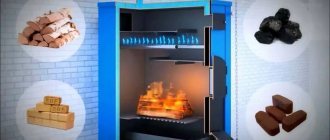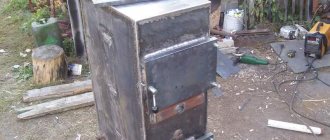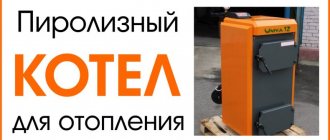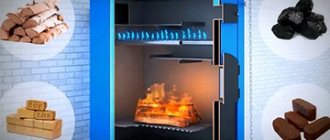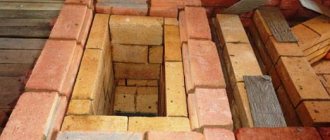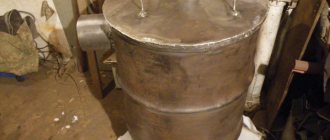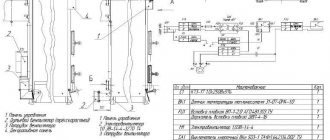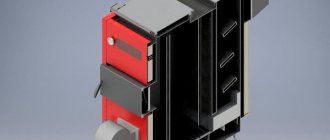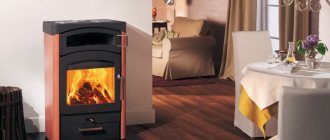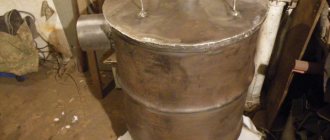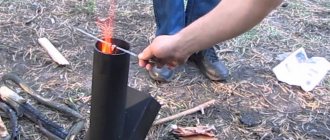Heating and hot water costs based on the consumption of energy carriers such as gas and electricity are growing annually. If residents of megacities in apartment buildings have little influence on the choice of fuel, then people living in low-rise or private housing can look for more acceptable options for themselves from available and traditional energy sources.
Until recently, the use of coal, peat, and especially firewood seemed archaic and a return to the stove primitive due to the complexity of automation and control of solid fuel combustion. Progress does not stand still; a large number of modern solid fuel boilers have appeared, equipped with perfect automation, interesting design, high technological and economic indicators. Pyrolysis solid fuel boilers are a striking example of such progress.
Detailed scheme of work, 6 stages
- After the firewood has ignited, the damper closes and the smoldering stage begins.
- Oxygen is pumped into the chamber, in a small amount, but sufficient to support smoldering.
- At this time, pyrolysis gases are released.
- The gases enter the secondary combustion chamber where they combine with oxygen, which is artificially pumped.
- The combustion process of the mixture occurs, releasing heat. Part of the energy goes to the heat exchanger to warm up the coolant, and part goes into the primary chamber to maintain the pyrolysis process.
- The spent combustion products exit through the chimney, passing through an additional heat exchanger and giving off the remaining heat.
The entire combustion process occurs under the control of a thermal control system. It can be adjusted to a specific room temperature.
What types of gas-generating boilers exist?
Diagram of a boiler with a lower gas combustion chamber
As you already understood, such boilers contain two combustion chambers: the primary loading furnace (where the wood burns) and the combustion chamber (where the gas directly burns). But, according to their location, fireboxes can be of two types:
- with a lower combustion chamber,
- with an upper combustion chamber.
Manufacturing nuances
From the above, it becomes clear that many complex chemical processes will take place inside the future home-made boiler, and the efficiency and safety of the unit will depend on how correctly they are carried out. Therefore, if a choice has been made in favor of developing the circuit and assembling a home-made unit, this process must be taken with great responsibility.
The situation is complicated by the fact that open sources do not have many drawings, as well as detailed photos of boiler designs. Most of them are generic and lack step-by-step instructions as well as details.
There are two options to solve this situation:
- Buy drawings with step-by-step assembly instructions from manufacturers or people who have good experience in the design, manufacture and testing of gas-generating boilers.
- Take up books and modeling programs yourself to develop a design and drawings for a pyrolysis boiler.
When designing, working out step-by-step instructions, as well as manufacturing, you need to take into account the following features:
- The material from which the gasification, combustion and post-combustion chambers will be made must be steel with a heat-resistant lining. The reason for this is 1000 °C inside the combustion chamber. If you use standard sheet steel, it will burn out in two or three seasons. According to many videos, it most often burns out under the combustion and afterburning chambers.
- It is better to make a water heat exchanger. Although it is more complex because it requires the manufacture of two containers that are connected by a system of pipes, it is more reliable and lasts longer. As for the fire tube heat exchanger, it lasts less, because the pipes must be heated to a temperature of more than 600 ° C. Such heating leads to rapid burnout. People choose such heat exchangers because they are easier to manufacture, because they represent one water container with a small number of vertical tubes placed inside it.
- The heat exchanger is placed only in the rear chamber. It should not be placed in chambers where fuel burns. This is because it will absorb heat, which will disrupt the processes of pyrolysis and combustion of gases. The efficiency will become less.
- Cameras should be made round or rounded. If the design of the pyrolysis boiler includes rectangular containers, then the efficiency will be lower, because that part of the heat that disperses to the corners will simply disappear without giving any benefit. Moreover, such a leak will reduce the temperature in all chambers and disrupt the processes that occur in them. The ideal cameras are round. They look like a barrel placed on its side.
- The nozzles also need to be made round. Ideally, they should be in the shape of a circle. However, such holes quickly become contaminated with ash and need to be cleaned. The latter process damages the lining. Therefore, it is worth choosing a nozzle with a slit that runs through the entire length of the bottom. Due to this solution, the efficiency does not drop very much - up to 3%.
Design
A pyrolysis boiler consists of a fuel chamber divided into zones. In one of them, called the gas generator, the fuel is decomposed into ash and pyrolysis gases, in the other, the afterburning zone, these gases are burned.
- Boilers are available in two types:
- with top loading, or shaft;
- with bottom loading.
Top combustion mine boilers
To overcome aerodynamic drag and stabilize the draft, the chamber is equipped with a blower fan installed on top of the boiler - this process is called “top blast”. Some models are equipped with another fan that supplies a stream of air directly to the afterburner, which increases the efficiency of the boiler. After combustion, smoke and steam are discharged into the chimney through the smoke pipe.
Boilers with bottom combustion In this type of heating units, the gas-generating chamber is located at the bottom, and the pyrolysis gases rise upward under the influence of draft. For stable combustion, such boilers require a chimney with a height of at least 5 meters.
The use of a fan for boilers with bottom loading is not necessary, because air is supplied through the damper. The efficiency of bottom combustion boilers is lower than that of mine boilers, but they do not depend on the availability of electricity.
Heat exchanger and connection of the boiler to the heating system
Next to the firebox there is a heat exchanger through which the heating system coolant circulates. The design of the heat exchanger depends on the model of the unit. Fittings are provided for supplying and draining water into the system. The inlet fitting, through which water that has cooled in the heating system enters the boiler, is located in the lower part of the heat exchanger. The outlet fitting is at the top. Water, preferably distilled, or antifreeze can be used as a coolant.
Long-burning gas generators can operate in systems with natural or forced circulation. When choosing a boiler, it is necessary to agree on the volumes of the heat exchanger and the coolant required to fill the heating system. The system is equipped with an expansion tank, and for forced circulation - with a pump, which is installed immediately before entering the boiler.
To stabilize the temperature in the heating system, it is also recommended to install a heat accumulator - a storage tank, which will be an intermediate link between the boiler and heating devices. At the same time, during breaks in the boiler furnace, the system will not cool down by more than 10-15 degrees. The water entering the heat exchanger must have a temperature specified by the manufacturer, usually 60 degrees Celsius. To maintain this temperature, the systems are equipped with a pipe for mixing hot water. In systems with forced circulation, in case of a sudden power outage, it is also necessary to provide a bypass to bypass the circulation pump.
A number of models of pyrolysis gas generators, in addition to heating, can also be connected to a hot water supply circuit; such boilers are called double-circuit boilers. It is convenient if the unit can be operated with the heating system turned off, only for heating water, which will allow it to be used in the summer. Typically, such models are equipped with additional heating elements built into the heat exchanger.
Housing material
Long-burning solid fuel boilers usually have a steel body with a thickness of 3 to 8 mm.
- But some manufacturers offer cast iron boilers, which have a number of advantages:
- cast iron has increased corrosion resistance compared to steel; cast iron boilers are not afraid of low-temperature corrosion;
- cast iron boilers with a forged heat exchanger do not have welds, where the destruction of steel most often begins;
- the thicker walls of cast iron units are not subject to burnout and deformation;
- due to their greater thickness, they do not cool down longer, which allows you to maintain the temperature in the system during a break to clean the boiler.
- Cast iron models also have disadvantages:
- they are much heavier, 2-2.5 times;
- the price is higher than that of steel, by about 50-70%.
Fuel requirements
Most modern models of pyrolysis boilers are equipped with automatic control of the combustion mode. The duration of combustion depends on the type of fuel. As a rule, when fired with dry wood, the gas generator can operate on one load for up to 12 hours, and on coal - for about a day. The use of sawdust, shavings, and woodworking waste somewhat reduces the burning time without additional loading.
Firewood must be dry, with a moisture content of no more than 16%. When using pellets or briquettes, such humidity is guaranteed by the manufacturer; the firewood must be dried in the shade for at least a year.
The best known manufacturers and models: characteristics and prices
The market for gas generator boilers is saturated with many types of imported and Russian-made equipment. Traditional leaders in the creation of high-tech heating systems based on pyrolysis units are German manufacturers. Their equipment meets the highest environmental requirements, the highest efficiency and economic efficiency. But the prices for German boiler units are appropriate.
The presence of Czech and Italian companies is noticeable, producing similar high-quality products and occupying the middle price segment of offers in the gas generator boiler market.
In recent years, the Russian production of boiler equipment has made significant progress towards the production of decent quality gas generator units for heating at a significantly lower (2-3 times) price for products that are close to imported ones in terms of characteristics and performance. Considering that it is better adapted to existing fuel and operational realities, purchasing it is interesting not only for a limited budget.
Burzhuy-K "Modern-12"
This series, combining energy independence and an affordable price, is one of the best among pyrolysis boilers for heating a private home. The interval between adding firewood is 12 hours, and coal is 15 hours. The boiler is efficient up to 50% fuel moisture content, although with a slight decrease in efficiency. The efficiency with fuel that meets the requirements reaches 92%, which is a very respectable figure, especially for the level of domestic manufacturers.
The boiler runs on any solid fuel; for natural draft they need a chimney with a height of at least 7 m (quite a lot, but realistic). The structure is fireproof, sheathed in steel sheets with basalt coating and does not require permits from supervisory authorities, weight - 220 kg. According to operating practice, it is considered absolutely problem-free, which is understandable, because the design is as simple as possible and non-volatile.
Efficiency and selection criteria for long-burning coal-fired boilers
Trayan TB-10-2KT
Gas-generating double-circuit boiler with a rated power of 10 kW, the control range allows a reduction of up to 40% of the nominal value. Non-volatile, with mechanical control. Efficiency depending on adjustments and fuel is 82-85%. The main feature, in addition to the DHW circuit, is the extremely compact dimensions - 450x890x730 mm (WxHxD). Supplied with a thermometer, pressure gauge and mechanical Honeywell damper regulator for air supply.
It is simple and safe to use; the period between loadings of dry fuel with proper regulation of the boiler operation reaches 10 hours. To maintain the coolant temperature at low loads, heating elements up to 3 kW can be connected (optional); a full set of volatile automation is also optionally available. Boiler weight 190 kg.
Cost: 43,000-53,000 rubles.
Buderus Logano S171-22W
It is included in the rating as one of the most high-tech boilers with a lower afterburning chamber for pyrolysis gases made in Germany. The main fuel is wood with a log length of up to 58 cm, which is extremely practical. Efficiency reaches 89%, equipped with the most modern automation systems: adjustable blower fan and smoke exhauster motors; control of heating system pumps; temperature sensors in rooms; control from mobile phone and PC.
The quality of heating system control allows you to save fuel and ensure high environmental safety. The large loading chamber ensures a burning duration of 3-4 hours and an average wood consumption of 6.2 kg/hour. Providing the highest level of user comfort while maintaining intuitive functionality also requires high service requirements. Overall dimensions of the unit are 1136x620x1019 mm, weight 362 kg. The only disadvantages are that they are intended for burning wood only, the heavy weight due to the heat exchanger made of 5 mm steel, and the high price.
Cost: 179,000-198,000 rubles.
Atmos DC 18S
Czech gas-generating single-circuit long-burning boiler with a built-in fan-smoke exhauster. The 20 kW model has a loading chamber of only 65 dm3, but the combustion duration of one load of firewood can reach 12 hours. The best fuel for it is logs up to 33 cm long and up to 15 cm in diameter, which, of course, is not so practical. But a well-functioning boiler allows you to save up to 40% of fuel per season, firewood consumption is 3.8 kg/hour, efficiency can reach 90%. The control is partially mechanical, but due to the fan and automation, the boiler requires connection to the electrical network. The heat exchanger is made of 6 mm alloy steel.
An important feature of such boilers is a built-in smoke exhauster; it eliminates smoke when reloading firewood, promotes rapid heating of the chimney and eliminates odors. Pyrolysis units of this type can be retrofitted with special pellet burners. Overall dimensions 590x1180x845 mm, weight 269 kg.
"Suvorov-M" K-10
Domestic pyrolysis single-circuit long-burning boiler with an open firebox (air flow is not forced) with a rated power of 10 kW, its control range is from 2.2 kW to 12 kW. Large loading firebox, one stack of logs burns for 10-14 hours, and fuel briquettes for up to 36 hours. The use of hardwood increases the burning time by 20-30%; with good quality sawdust briquettes, the smoldering time increases significantly. The length of the logs can be up to 45 cm, the full load of dry firewood is 14 kg, their consumption is 2.9 kg/hour.
The boiler uses any solid fuel. The humidity of the raw materials should not exceed 25% to achieve an efficiency of 92%. Non-volatile, it is possible to connect a hot water supply circuit and install heating elements. Overall dimensions 990x535x780 mm, weight 185 kg.
Cost: 62,000-64,000 rubles.
"Suvorov Ultra" K-15U
Long-burning mine gas generator boiler with a nominal power of 15 kW, its control range from 1.7 kW to 20 kW. The burning time of firewood is up to 65 hours, fuel briquettes are up to 120 hours. The 140 liter firebox can accommodate logs up to 40 cm (not so practical, but sufficient), and the loading weight is 46 kg. The humidity of firewood, at which the maximum efficiency of 94%-95.7% is achieved, should not exceed 25%. The height of the chimney, measured from the grate, must be at least 6 m - a completely standard requirement.
The shaft layout of the boiler with bottom combustion of fuel, innovative engineering solutions associated with increasing the length of a special three-turn gas path, made it possible to increase the burning time of firewood, and therefore squeeze the maximum possible out of it. Overall dimensions of the boiler are 1210x560x875 mm, weight 295 kg.
Cost: 93,000-96,000 rubles.
The operating principle of pyrolysis boilers and their features
By creating pyrolysis boilers with their own hands, people strive to save money in their wallet. If gas equipment is quite cheap, then solid fuel units are simply amazing in their price. A more or less decent model with a power of 10 kW will cost 50-60 thousand rubles - it would be cheaper to install gas if there was a gas main nearby. But if it is not there, then there are two options - purchase factory equipment or make it yourself.
It is possible to make a long-burning pyrolysis boiler with your own hands, but it is difficult. Let's first figure out why pyrolysis is needed in general. In conventional boilers and stoves, wood is burned in the traditional way - at high temperatures, with the release of combustion products into the atmosphere. The temperature in the combustion chamber is about +800-1100 degrees, and in the chimney - up to +150-200 degrees. Thus, a significant part of the heat simply flies out.
Direct combustion of wood is used in many heating units:
Solid fuel pyrolysis boilers can use several types of fuel, including waste from wood processing and agricultural processing.
- Solid fuel boilers;
- Stoves-fireplaces;
- Fireplaces with water circuits.
The main advantage of this technique is that it is simple - it is enough to create a combustion chamber and organize the removal of combustion products outside the equipment. The only regulator here is the blower door - by adjusting the clearance, we can adjust the intensity of combustion, thereby influencing the temperature.
In a pyrolysis boiler, assembled with your own hands or purchased in a store, the process of fuel combustion proceeds somewhat differently. Firewood here burns at a low temperature. We can say that this is not even combustion, but slow smoldering. In this case, the wood turns into a kind of coke, simultaneously releasing flammable pyrolysis gases. These gases are sent to the afterburning chamber, where they burn, releasing a large amount of heat.
If you think that this reaction will not give much effect, then you are deeply mistaken - if you look into the afterburner chamber, you will see a roaring flame of a bright yellow, almost white color. The combustion temperature is slightly above +1000 degrees, and more heat is released in this process than during standard wood combustion.
In order for a self-assembled pyrolysis boiler to show maximum efficiency, firewood with a low moisture content is needed. Wet wood will prevent the equipment from reaching full capacity.
The pyrolysis reaction is familiar to us from our school physics course. In the textbook (and maybe in the laboratory office), many of us saw an interesting reaction - wood was placed in a sealed glass flask with a tube, after which the flask was heated over a burner. After a few minutes, the wood began to darken, and pyrolysis products began to come out of the tube - these are flammable gases that could be set on fire and observe a yellow-orange flame.
A do-it-yourself pyrolysis boiler works in a similar way:
Pyrolysis boilers operate for about 4-6 hours on one load of fuel. So it’s worth taking care of a large and steadily replenished supply of firewood in advance.
- Firewood is lit in the firebox until a stable flame appears;
- After this, the access to oxygen is blocked, the flame goes out almost completely;
- The blower fan starts and a high-temperature flame appears in the afterburning chamber.
The design of a pyrolysis boiler is quite simple. The main elements here are: a combustion chamber in which firewood is stored, and an afterburning chamber in which pyrolysis products are burned. Heat is transferred to the heating system through a heat exchanger
In the pyrolysis boiler design, special attention is paid to it
The thing is that the heat exchangers in pyrolysis boilers, assembled with your own hands, are arranged differently from those in gas equipment. Combustion products with air pass here through many metal pipes washed with water. To increase efficiency, boiler water washes not only the heat exchanger itself, but also all other components - a kind of water jacket is created here, which removes excess heat from the hot elements of the boiler unit.
Pyrolysis boiler in the house: features of operation
In general, if you live in a place where gas mains are available, then the simplest solution is to install a standard gas boiler. However, despite their convenience, gas boilers are still not suitable for everyone. Firstly, installation will require a connection to the gas network, and if there is none, then you are left without heating. Secondly, gas boilers are far from the most economical. Burning gas, of course, is easier than wood or other solid fuel, but it is very wasteful, especially when it comes to a large house.
In other words, a pyrolysis boiler is an excellent alternative to standard equipment. Installing the boiler is possible with your own hands, setting it up is not a problem, and the use of such equipment has many advantages. How does such a boiler work? The corresponding equipment is called a gas generator boiler, but it still belongs to solid fuel equipment, how did this happen?
The fact is that the pyrolysis boiler has a special cunning device, thanks to which gas is extracted directly from the wood that is burned. You put firewood into the boiler, it burns it, and at the same time produces gas, which is also used for heating. Thus, the boiler generates gas, which became the basis for its name.
To obtain gas from wood, difficult conditions must be met:
- High internal temperature;
- Boiler tightness;
- Lack of oxygen inside.
In other words, it’s not so easy to immediately take and burn gas; the boiler must be heated, some of the wood burned, during which all the oxygen will be absorbed and, provided it is sealed, the process of gas generation will begin.
Instructions for making a pyrolysis boiler
The most optimal for assembly is a pyrolysis boiler with a capacity of 25 kW or more. It is capable of heating large rooms with an area of 180 m2.
To make it you need the following materials:
- metal sheets with a thickness of at least 0.8 mm;
- 15−20 pieces of fireclay (fireproof bricks);
- temperature sensor system;
- grate;
- 3 pipes with a diameter of 5.7 cm, 3.2 cm and 16 cm (for supplying cold and hot water, as well as for the supply line of the boiler circuit);
- 2 professional pipes (for emergency line and exit pipes);
- blower fan;
- temperature sensor;
- drawing and size table for boiler assembly;
- 2 doors for the firebox and ash pan;
- fastenings made of burnt wire for doors;
- grinding wheels - 10 pieces.
Required tools:
- electric welding machine;
- Bulgarian;
- angle grinder.
Manufacturing process
- It is necessary to cut 4 walls for the boiler from steel sheets. Make holes in the front wall for the firebox and the ash pan located underneath.
- Cut holes for the smoke exhauster and for the pipe pipes. Connect all metal walls (except the back) using a welding machine, and the joints between the sides of the future boiler must be sanded.
- Next, the heat exchanger is assembled, as shown in the figure. The pipes are welded using a welding machine. Before welding, it is necessary to “put on” grinding wheels on the pipes themselves to remove joints and seams between them.
- Then you need to install the heat exchanger into the future boiler as in the figure. Before closing the device with the back wall, it is necessary to check it for leaks with a compressor. If there are none, the back of the boiler is welded.
- Next, you need to install a grate that will separate the place of gasification and fuel combustion. The lower section, where the fuel will be burned, is equipped with an air duct and lined with fireclay (fireproof) bricks on all sides, including the bottom.
- Then you need to attach the doors to the corresponding compartments for the fuel supply and ash pan. They should fit snugly against the walls of the boiler.
- At the end, the finished boiler is installed on a brick surface and connected to a pipe insulated with non-flammable insulation (for example, foil-lined mineral wool). Without this, tar will settle on the pipe walls, which will significantly shorten the service life of the boiler. A water circuit and a smoke pump are connected to the device.
- In order for the boiler to operate automatically, just like a production boiler, it is necessary to install a temperature control system. It is needed in order to regulate the operation of the smoke exhauster, as well as the air supply.
- The installation of the boiler does not end there. It is necessary to check its efficiency. If, after turning on the boiler, you do not detect the smell of carbon monoxide from the smoke coming out, then its efficiency is high enough and the equipment is safe for use.
Thus, if you have initial skills in working with a grinder and a grinder, and if you understand basic drawings, you can easily assemble a pyrolysis boiler yourself. And this is not only comfort and warmth in your home, but also very profitable financial savings.
Pyrolysis boiler size chart
- A-boiler circuit controller
- B - loading door
- Ash door C-door
- D-exhaust exhauster
- E-coupling
- F - emergency line connection
- G - boiler circuit supply line
- H - cold water supply
- K - Hot water supply
- L - Heat circuit return line
- M -Drain pipe and expansion tank
Size table (dependence of the power of the future boiler on the size of the parts).
Safety requirements and operating rules
Long-burning boilers, like any other heating equipment, are fire hazardous, since combustion processes in such a device can reach very high temperatures. When installing and using it, the following recommendations must be observed:
- place the boiler on a concrete or brick base, place a metal sheet with a thickness of 2 mm in front of the firebox to protect the floor from accidentally falling coals;
- the distance to the walls is at least 20 cm, and as far as possible from the furniture;
- It is desirable to have a separate boiler room; the opening for ventilation in it should be at least 100 square meters in size. cm;
- It is also recommended to carefully insulate the chimney through which combustion products are discharged. The lack of thermal insulation will not only lead to heat loss, but will also cause the formation of tar and condensation, which contribute to premature wear of equipment and numerous breakdowns;
- automation with temperature sensors will allow you to establish autonomous operation of the boiler and ensure fire safety. It is the automation that regulates the correct mixing of combustible gas with air according to a special scheme;
- it is imperative to install a boiler safety group: a pressure gauge, an automatic air vent and an emergency valve that bleeds air in case of excess pressure;
Construction or assembly of a long-burning boiler is not easy or cheap. Having made all the costs and calculations once and carried out all the work strictly according to the technology, the thrifty owner receives an economical and high-performance boiler, which in the process will save the family budget and time, making the house warm and cozy in the winter cold. If the operating rules are followed, this stove will heat rooms and heat water and will work properly for many years.
Design and principle of operation of the boiler
The primary combustion chamber or pyrolysis chamber resembles in its design the firebox of a conventional furnace. Solid fuel (firewood, sawdust, wood or peat briquettes, pellet granules) is placed through the loading window onto a massive fire-resistant grate - a grate, which provides an influx of air to the fuel, which is called primary.
Operating principle of a long-burning boiler
Pyrolysis gas is forced, less often by gravity, into a secondary chamber - a combustion chamber or afterburning chamber, into which a sufficient amount of air is supplied, which is called secondary. Upon contact with oxygen, gas heated to high temperatures (more than 300 degrees Celsius) instantly flares up and burns, releasing a large amount of heat. The main function of the boiler is performed - heating the coolant.
The operating principle of the pyrolysis boiler is shown in detail in the video.
The air is usually forced by a small fan. Although in small models sometimes a smoke exhauster is used to create draft.
This diagram shows the structure of a bottom combustion pyrolysis boiler. Firewood burns slowly with little oxygen and releases flammable gas ( )
The presence of forced ventilation can be considered the main difference between a pyrolysis boiler and a classic solid fuel model. The device body consists of two parts inserted into each other. The space between the walls is filled with a coolant, the role of which is traditionally played by water.
The combustion temperature can reach 1200°C. The water in the external heat exchanger is heated and circulated through the heating system of the house. Remains of combustion products are removed through the chimney.
Devices that use the pyrolysis combustion principle can be reproached with a relatively high price. A conventional solid fuel boiler costs significantly less. But in long-burning boilers, wood burns almost completely, which cannot be said about a classic boiler.
Firewood for a pyrolysis boiler has certain requirements in terms of size and humidity. Detailed information can be found in the manufacturer's instructions
When choosing a pyrolysis boiler, you should remember that inexpensive low-power models are usually designed only for firewood. Expensive modifications can operate on different types of fuel.
According to the method of fuel combustion, long-burning boilers with a double circuit can be divided into:
- Pyrolysis. Equipped with two combustion chambers. In one of them, the process of smoldering and the release of gas for pyrolysis occurs, in the other, the resulting gas is mixed with oxygen and burned. Equipment of this type is characterized by high environmental friendliness - a minimal amount of harmful substances is released into the atmosphere. The combustion process produces little soot. If the boiler is equipped with automation, power adjustment will be possible.
- With upper combustion chamber. Such boilers are very easy to maintain. The amount of automation required for their stable operation is minimal; it is possible to operate in autonomous mode without electricity. There are also disadvantages - a lot of ash is generated during operation, there is a list of requirements for fuel types. For example, small wood chips or sawdust are not suitable for kindling.
- Pellet. To kindle such equipment, special pellets or compressed fuel briquettes are used. Such boilers are environmentally friendly, economical and efficient, and have a long service life. One of the main disadvantages is the high price of the boiler and the special conditions that will have to be maintained for fuel storage. The room should be dry; high air humidity will contribute to the deterioration of pellets.
Advantages and disadvantages
- Compared to other solid fuel heating units, pyrolysis boilers have a number of advantages:
- complete combustion of fuel, and, as a result, saving firewood, reducing the amount of ash and soot;
- fire safety - the fuel chamber is sealed, and the chimney does not heat up to dangerous temperatures;
- long-term work on one load - there is no need to constantly monitor the level of firewood and add it;
- automatic regulation of the combustion mode due to fans that generate draft and supply air;
- use of firewood of large diameter and length.
- However, they are not without their disadvantages, most of which can be solved by proper installation and operation:
- pyrolysis boilers have a fairly high price compared to conventional solid fuel boilers;
- due to the need for fans to operate, they are energy dependent, and in places with frequent power outages it is necessary to provide an additional power source, for example, a generator;
- Dry firewood is necessary for efficient operation, otherwise there will be too much water vapor in the pyrolysis gases, which will lead to incomplete combustion, reduced efficiency and even extinguishing of the boiler;
- the boiler must be loaded to rated power, otherwise the smoke temperature will drop, condensation will begin to form on the walls of the combustion chamber and chimney, which will lead to their contamination with soot and corrosion;
- the correct design of the connected heating system is required - at the entrance to the boiler jacket, the coolant temperature should not be lower than 60 degrees Celsius to avoid condensation and low-temperature corrosion.
DIY pyrolysis boiler: rules and nuances
Do-it-yourself pyrolysis boiler In order to install a pyrolysis boiler with your own hands, while maintaining all its working qualities, it is necessary to rely on accurate drawings and calculations. An incorrectly assembled boiler, installed according to an incompetent design, will not only perform its functions poorly, but will also pose a safety threat to the environment and to you in the first place.
Rules for assembling a pyrolysis boiler with your own hands:
- Your first priority, before starting assembly, is to familiarize yourself with the drawings, plans and diagrams. They will help determine the amount of material needed for work, and will also protect you from possible emergency situations;
- Check the presence of fundamental elements, without which it is impossible to assemble the pyrolysis boiler yourself. These are: regulators, air holes, smoke channels, water drainage pipes, combustion chamber, water supply pipes, and a fan;
- Please note that if you plan to heat a standard country house, a 40 kW pyrolysis boiler is quite suitable for you, and if you are the owner of a very small cottage, then a 30 kW boiler will be enough. There is no point in installing super powerful boilers, since a small device will perfectly insulate the premises, while huge units will cost a lot of money and require significant expenses;
- It will not be superfluous to prepare the necessary tools for installing the boiler. So that you don’t have to run to the hardware store one more time, prepare everything you need right away. To install a pyrolysis boiler with your own hands, you will need the following tools: grinder, grinding wheels, welding machine, electric drill, pipes of various diameters, electrodes, fan, steel strips, temperature sensor, metal sheets
Please note that assembling a pyrolysis boiler with your own hands is a long and painstaking process, so be prepared for possible difficulties. However, by carefully preparing for the process, you significantly reduce the risk of unexpected problems.
After all the rules have been followed, the desired circuit has been selected, it’s time to begin the actual assembly. When assembling the device step by step, make sure to comply with the following nuances:
- Unlike conventional boilers, the hole for placing firewood in the firebox should be located slightly higher;
- Be sure to check the presence of a restrictor that fixes the air supply to the boiler. Its optimal dimensions are 70 ml in cross-section and a length exceeding the dimensions of the body;
- The disk welded to the limiter must be made of stainless steel and located at the bottom of the entire structure;
- It is best to have a rectangular shape for the hole for supplying solid fuel. For a pyrolysis boiler, this shape is optimal;
- The door must close tightly and securely; a special lining is required that will tightly secure the closure;
- Provide in advance and then do not forget to make a special hole with which you will remove accumulated ash;
- The coolant pipe should not be straight, but slightly curved. This shape is necessary to increase heat transfer;
- The location of the valve should be convenient and accessible. Thanks to it, you will control the process of air entering the firebox;
- First start. After you have completed assembling and installing the pyrolysis boiler yourself, conduct a test run of the device. Using special equipment, check the correct operation at all stages and make sure that carbon monoxide does not accumulate in the boiler. Only after this can the boiler be fully put into operation.
Design of a homemade unit and calculation of materials
A do-it-yourself pyrolysis boiler is made mainly with an upper loading firebox, under which there is a gasification chamber. It is easier to manufacture and has good efficiency. If you have some engineering skills, you can make changes to the finished drawing, but the internal dimensions are left the same or with minor adjustments. It is better to make the fireboxes the same in width and length, the only differences being in height.
To calculate whether the device is suitable in terms of power, we proceed from the following rule: every 10 m2 of room requires 1 kW of energy. The value is multiplied by a factor of 1.2, but in practice it is increased to 1.5, since high-quality fuel is not always available. If, for example, we assume that the device produces 20 kW, then it is capable of heating 200 m2 of area, but taking into account the reserve - 130 m2. A boiler of this performance is available for self-production; with higher power, the use of special heat-resistant steel of large thickness is required. It is difficult to cook it at home.
It is recommended to use heat-resistant alloy steel for cameras, but its cost is significant, so it is replaced with simple carbon steel 5 mm thick. The burning gas creates a high temperature in the working area of the compartment. To protect the metal, a cast iron grate is installed at the bottom of the filling chamber, and the bottoms of both fireboxes are lined with refractory bricks.
The water jacket operates under pressure, which requires high quality seams. The main factor preventing this is hot and cold cracks, which are formed due to a high temperature difference over a relatively short length of the product. To reduce the negative consequences, several technological techniques are used:
- the metal is cut by smoothly feeding the cutting tool to protect the edges from overheating;
- welding is carried out in a soft mode, reducing the required current by 20–25%;
- the seam passes without lateral vibrations at high speed;
- They line it with thick metal for faster cooling.
The designs of many pyrolysis boilers do not provide for the use of water as a coolant. Then the exchanger is not sealed; hot air enters the room through its pipes, and the influx of cold air comes from the floor. This solution has its advantages, especially for summer residents who occasionally visit their country house. Then there is no risk of the system defrosting.
You can significantly reduce the cost of a homemade installation by choosing the right metal and equipment. The required materials and their characteristics are given in the table:
| Name | Dimensions, mm | Consumption |
| Round pipes | 57×3,5 | 8 m |
| 159×4,5 | 1m | |
| 32×3,2 | 1m | |
| Profile pipes | 60×30×2 | 1.5 m |
| 80×40×2 | 1m | |
| 20×20×2 | ||
| Steel strips | 20×4 | 7.5 m |
| 30×4 | 1.5 m | |
| 80×5 | 1m | |
| Fire brick | 15 pieces | |
| Sheet metal | 3 and 5 mm | 10 m2 |
As for the tools, in addition to the welding machine, you will need grinders with the ability to install disks with a diameter of 230 and 125 mm. Circles require 10 large and 5 small. The use of an angle grinder for cutting metal does not provide accuracy, which then affects the quality of the seams. It is better to order production using a guillotine in a workshop. An electric drill will come in handy. Perhaps during work there will be a need to buy some more material, but this can be solved.
Difficulties
Tightness is one of the main difficulties that arises when building a pyrolysis boiler with your own hands. That's why they check it twice.
The first time this happens is when all the main components of the boiler are welded, but its interior is still open. The holes for the coolant are blocked tightly with plugs and water is drawn into the boiler. A mark is made at the location where the leak is detected. This part is then digested again.
The boiler is checked the second time when the entire system is completely assembled. To do this, along with water, a pressure tester is used, which pumps up a pressure of 3-4 bar, which should not drop sharply. If it remains at a stable level, then the unit is sealed.
Operating principle of a pyrolysis boiler
In relation to heating boilers, pyrolysis is the combustion of fuel with insufficient oxygen. In this case, the fuel emits a large amount of gases, almost all of them are flammable. These gases are sent to a special combustion and afterburning chamber, where secondary air is supplied. The gas-air mixture ignites, releasing a large amount of heat. Much more thermal energy is released than can be extracted by conventional combustion of wood or coal. The fact is that many of the volatile substances formed during fuel combustion have a very high combustion temperature. As a result, pyrolysis boilers extract more heat from the same amount of fuel.
A design feature of pyrolysis boilers is a firebox consisting of two chambers. Fuel is placed in one (often this is the upper part of the furnace), gases are released in it, and therefore this part is called the gas generation chamber. Through a narrow neck, gases enter the second chamber - afterburning. Here they mix with secondary air, flare up and burn with virtually no residue.
Pyrolysis boiler with lower afterburner chamber
On average, the efficiency of pyrolysis machines is above 85%. There are models capable of delivering 92% and even a little more. But these indicators are possible only and exclusively when using dry fuel. Its humidity should be 5-8%. At 40% moisture content, combustion can completely extinguish, and at 20% it will simply be ineffective. And this is one of the main disadvantages of this technology: firewood and coal have to be dried first, for example, by making a platform near the chimney. Just firewood dried in a woodshed will not work, nor will coal taken from a pile on the street.
The video demonstrates a boiler in which the afterburner chamber is located at the top. Although boilers of this type have a simpler structure (the resulting gases themselves rise upward), homemade boilers prefer a chamber with a lower location of the afterburner (as in the photo above).
What fuel is suitable
The fuel moisture content should not exceed 25%, otherwise energy will be spent on water evaporation, the power will be lower than necessary, and water vapor will begin to dilute the released gases and interfere with combustion. As a result, the boiler will stop working.
Otherwise, the choice of fuel often depends on the model. There are devices that are exclusively wood-burning, and some units can work well on other types of combustible materials, such as brown or coal.
The most effective gas generator systems are those running on fuel with a high yield of volatile substances:
- firewood;
- pellets;
- wood waste;
- fuel briquettes;
- brown coal.
When choosing a material, you also need to focus on the duration of its combustion. To burn soft wood it will take 7 hours, compressed sawdust, peat and hard wood - 9-10 hours. The smoldering time for brown coal is limited to 10–11, and for black coal – 12–14 hours.
The greatest power will be provided by natural firewood with log lengths of 450–650 mm. In addition, the use of this type of fuel helps to increase the service life of equipment.
